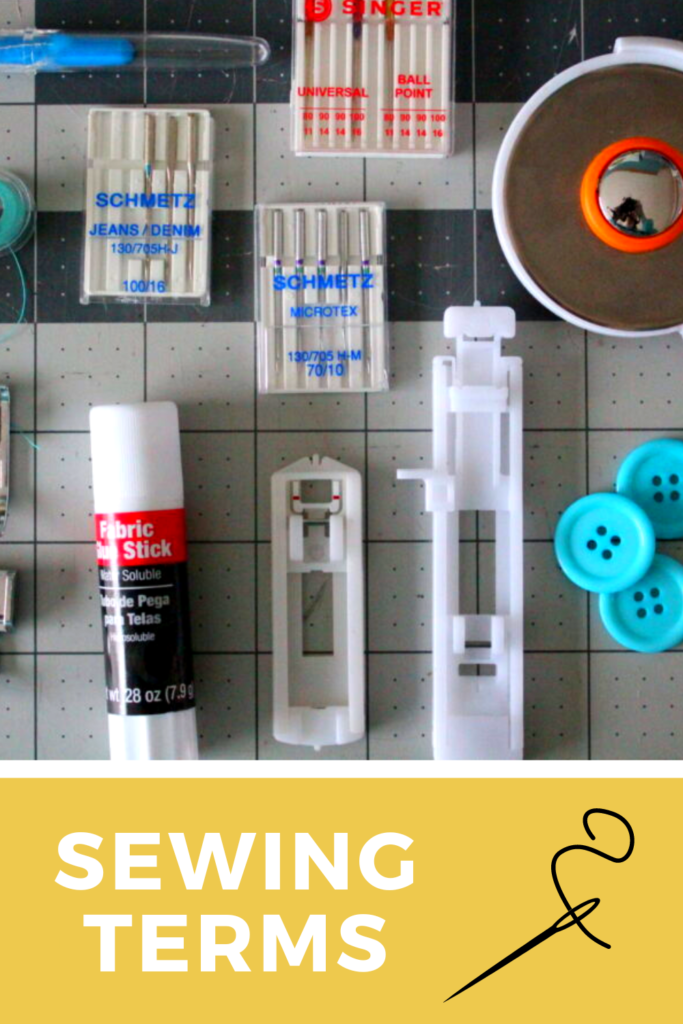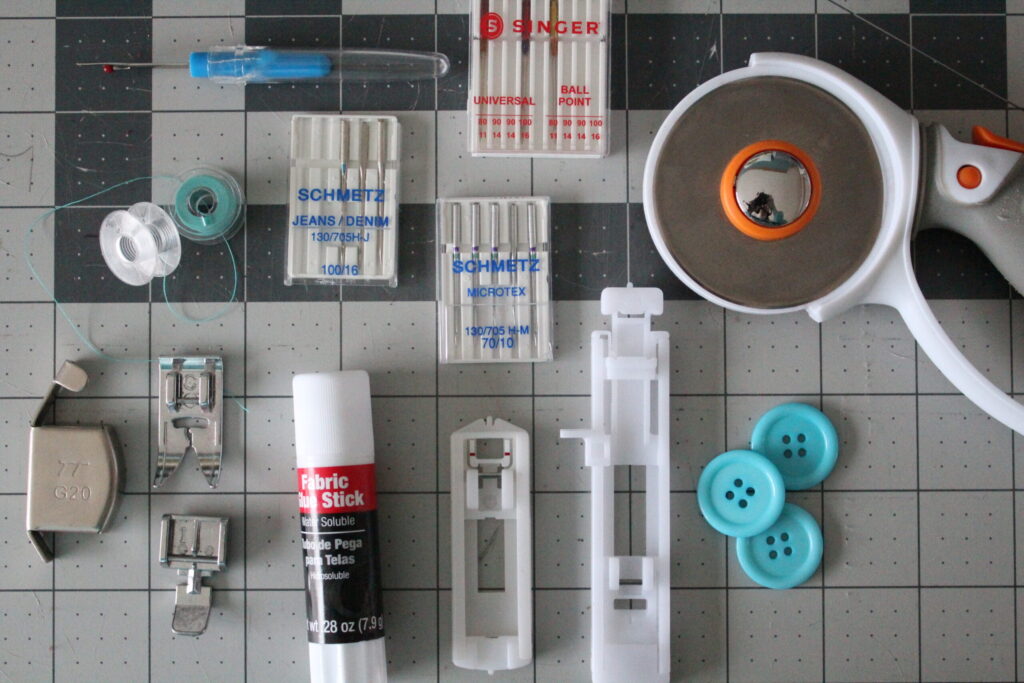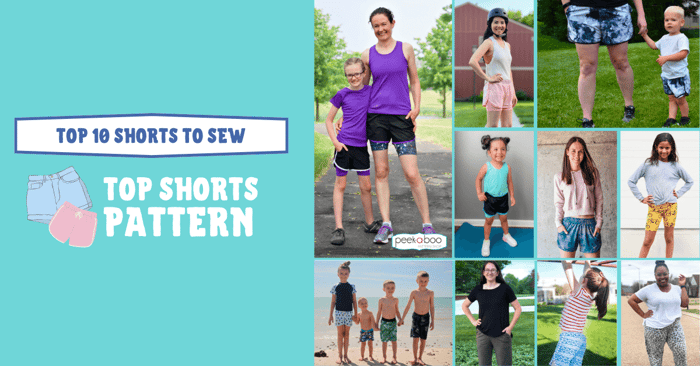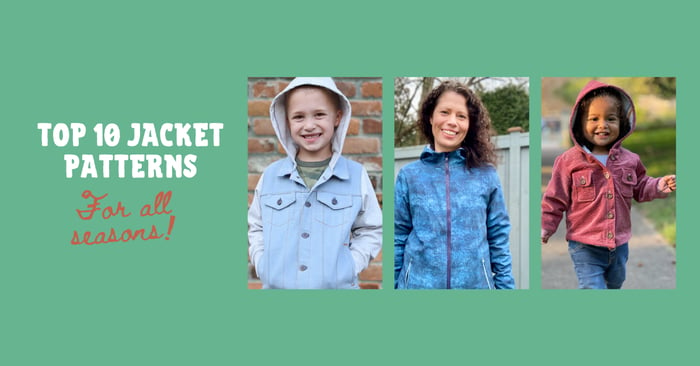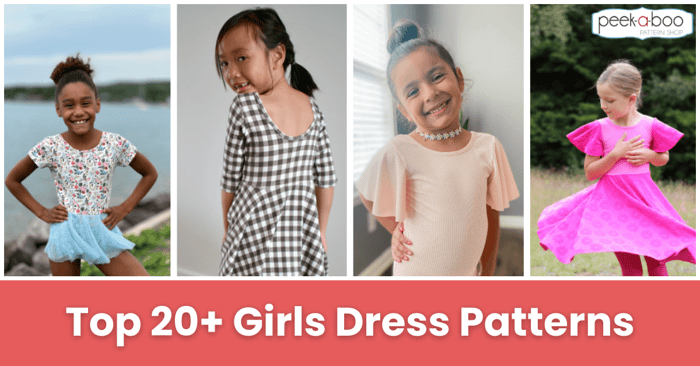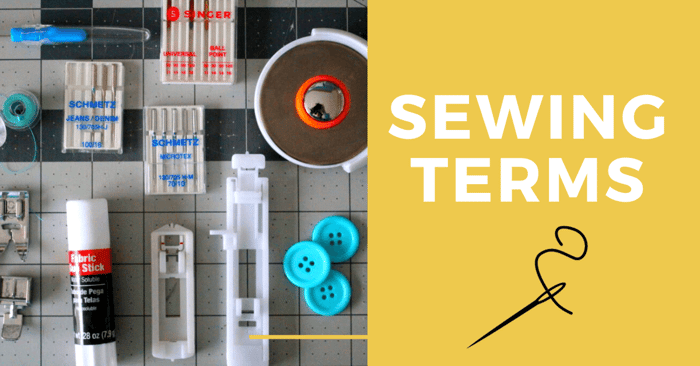
Sewing Terms | Learn Sewing Vocabulary
Today – we’re going to go over some basic sewing terms. Are you just beginning your sewing journey, but you aren’t sure where to start? Or maybe this isn’t new for you, but you’d like a refresher? Well, this list is by no means exhaustive in the realm of sewing but it could be a good start to help familiarize yourself with these terms and definitions listed below.
Whether your sewing projects include accessories, garments, quilts etc. or down to the type of fabric base being used; all of these decisions will require some knowledge that you will no doubt come across as you begin to sew. It will be of great help to familiarize yourself with sewing terms and definitions as you move forward and go along. Before you know it, it’ll just be second nature the further you press on!
So, let’s jump into the sewing terms!
Learn Sewing Terms | Guide to Sewing Vocabulary
Armscye
In sewing and garment construction, the term "armscye" refers to the armhole of a garment. It plays a crucial role in determining fit and comfort. Sewers carefully measure and adjust the armscye to ensure a seamless and comfortable fit. Mastering the armscye is essential for creating well-tailored garments like dresses, blouses, and jackets. This term is used in our shirt sewing tutorials like How to Sew Flutter Sleeves or Sewing Raglan Sleeves.
Backstitch
Backstitch is a sewing technique that reinforces seams and prevents unraveling. It involves stitching forward, then reversing direction to create a double line of stitching. This adds strength and durability to garments, quilts, and other sewing projects. Backstitching adds a professional touch and ensures creations withstand regular wear and tear.
To sew in reverse to lock your beginning and ending stitches in place. This technique will come in handy in many, many, sewing projects. See how it’s used in our How to Make a Box Pleat and the Eye Glass Case Tutorial.
Basting
Basting is a sewing technique that temporarily stitches fabric pieces together. It allows for adjustments before permanent sewing. Basting can be done by hand or with a machine, and it's useful for delicate fabrics or complex patterns. This technique ensures accurate and secure final stitches for a beautifully finished project. These basting stitches are put to use in the Pain and Panic Costume and Free Doll Dress Pattern.
Bias edge
The bias edge in sewing refers to fabric cut at a 45-degree angle to the straight grain. It has unique characteristics that make it perfect for binding and finishing edges. Cutting fabric on the bias provides more stretch and drape, making it flexible for curved or rounded edges. It also adds visual interest and texture to garments. Understanding and using the bias edge can enhance your sewing projects.

Bias Tape
Bias tape is a versatile sewing notion used to finish and bind fabric edges. It's made by cutting strips of fabric on the bias, allowing for stretch and flexibility. You can purchase pre-made bias tape or make it at home with a bias tape maker. With various colors and widths available, it offers creative options for garment construction and sewing projects. Whether adding a professional touch or creating decorative accents, bias tape is essential for sewing enthusiasts.
Learn more about the bias in our Make Your Own Bias Tape and 3 Ways to Use Bias Tape tutorials.
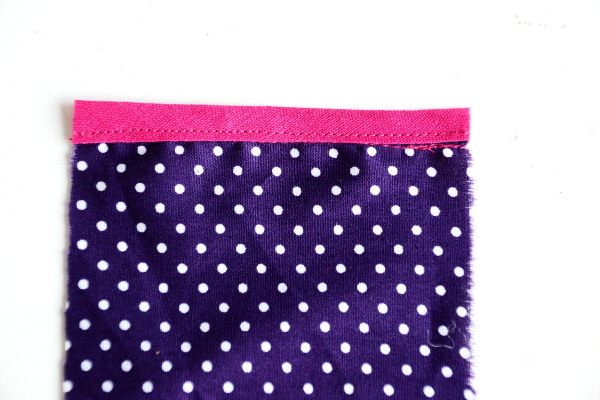
Binding
Binding is a fabric strip used to finish raw edges in sewing. It provides a clean and professional finish, enhancing durability and aesthetic appeal. It can be applied to necklines, armholes, hems, and quilt edges. Binding is an essential technique for achieving high-quality sewing results.
See the Bias Tape article referenced above or the Binding Knit Fabric tutorial.
Blanket Stitch
Blanket stitch is a simple and versatile sewing technique used to finish fabric edges. It creates a decorative border with small, vertical stitches resembling the teeth of a comb. This stitch adds decoration, prevents fraying, and enhances fabric durability. It can be used on various fabrics like blankets, quilts, clothing, and accessories. Crafters and sewists appreciate its simplicity and ability to create professional finishes.
Bobbin
A bobbin is a small spool holding the lower thread in sewing. It creates stitches with the upper thread, resulting in secure and durable seams. Depending on the sewing machine model, bobbins come in different sizes and materials. Knowing how to wind and insert bobbins is crucial for efficient sewing.
Learn more about this in How to Thread a Sewing Machine.

Bodice
A bodice is a fitted garment that covers the upper body, from shoulders to waist. It accentuates the bust and waist shape. It can be separate or integrated into a dress or gown. Historically, bodices were worn with corsets to create desired silhouettes. Today, they are found in formal gowns and casual tops.
Buttonhole
Buttonholes are functional slits in fabric for buttons on garments like shirts and jackets. They vary in size, shape, and placement based on design. Buttonholes add quality and aesthetic appeal to well-crafted clothing. Learn how to sew a buttonhole with our step-by-step tutorial.
Casing
An empty tube for inserting drawstring, elastic etc. is created by folding the fabric onto itself and sewing, creating a “tube.” Learn how to put casing to work in the DIY Apron Pattern or the DIY Headband.
Clip
Snipping your seam allowance around the curves to prevent puckering, being careful not to cut through the thread. Learn more about Clipping and Notching.
Color Blocking
Color blocking is combining or meshing different colored or patterned fabrics in a garment. We have a great Color-blocking Tutorial. Also, the Mix Tape Tee is great for color-blocking:

Crosswise Grain
An imaginary line that runs perpendicular from the selvage edge. The concept of the cross-grain is well explained at the beginning of our Sewing Piping article.
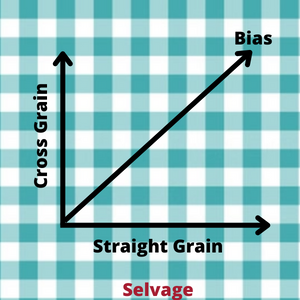
Cut on the fold
Fabric folded onto itself and then cut out to the shape of the pattern piece except for the area on the fold line. Learn how to cut on the fold in our How to Cut Out Pattern Pieces article.
Darning
Darning is a sewing technique that repairs holes or worn areas in fabric. It involves weaving thread through the damaged area to create new stitches, seamlessly blending it with the surrounding fabric. Darning can be done by hand or with a sewing machine and extends the life of clothing while preventing further damage. It's a valuable technique for seamstresses of all levels.
Darts
Darts in sewing shape and contour fabric to create a more fitted garment. They are triangular or diamond-shaped folds sewn into the wrong side of the fabric, typically at the bust, waist, or hip areas. Darts eliminate excess fabric and provide shape and definition to garments like dresses, blouses, and skirts. Mastering darts can greatly improve the fit and finish of your sewing projects.
Drape
The fluidity in which a garment hang’s. For a dress with drape and flow check out the Sicily Swing Dress Tutorial. Also, pick out the right fabric in our Apparel Fabric Guide.
Ease
The space allowance in a given pattern for comfort in each size.
Edge of the Fabric
To achieve a clean, professional look in sewing projects, it's crucial to properly finish the fabric edge. This prevents fraying and adds durability. Methods like serging, zigzag stitching, or binding tape can be used based on fabric type and desired aesthetic. Paying attention to the fabric edge is essential for a high-quality finish in any sewing project.
Edge Stitch
Edge stitching is a sewing technique that gives fabrics or garments a professional finish. It involves stitching close to the edge, typically between 1/8 inch to 1/4 inch away, using a straight or decorative stitch. This technique secures fabric layers, prevents fraying, and provides a clean look. Edge stitching is commonly used on hems, seams, collars, cuffs, and pockets to add structure and precision to your sewing projects, improving the quality and aesthetics of your garments.
Embroidery
Embroidery is a decorative art form that involves stitching designs onto fabric using thread, yarn, or floss. It can be done by hand or with a machine. With embroidery, you can add intricate details and colors to clothing, home décor items, and accessories. From floral motifs to geometric shapes, embroidery offers endless creative possibilities. Add beauty and uniqueness to your sewing projects with embroidery.

Embroidery Stitch
Embroidery stitch is a decorative sewing technique using needle and thread on fabric. It adds texture, color, and intricate patterns to garments, accessories, and home decor. There are various types of stitches like satin, stem, chain, and French knot. Learning these stitches can unleash your creativity and personalize your sewing projects.
Fabric glue
Used to hold something in place, such as a zipper, before permanently sewing in place. Chinmy recently put fabric glue to good work in How to Applique Fabric.
Facings
In sewing, facings are fabric pieces used to finish the edges of a garment. They provide a clean and professional look, stabilize and reinforce areas like necklines, armholes, and waistlines. Facings can be sewn directly or attached with interfacing for added support. They are essential for creating well-finished, functional, and visually appealing garments.
Feed-dogs
Jagged feet located under the presser foot move the fabric through the machine. See when and when not to use feed dogs in How to Topstitch an Elastic Waistband and How to Use Clear Elastic to Stabilize Knits.
Foot Pedal
The corded mechanism is plugged into the side of your machine that is pressed by your foot to operate it. We have a great video guide on using a foot pedal:
French Seam
A French seam is a strong seam that encloses the raw edges and seam allowance with stitches on both sides of the fabric. It gives a clean and professional look on both sides of the fabric.
Gather
To shorten a longer piece of fabric to size by gathering (pulling the threads) to create ruffles or fullness. We have lots more information on this – check out our guides on How to Gather Knit Fabric, How to Gather Fabric 8 Ways, and How to Sew Gathered Sleeves for starters.
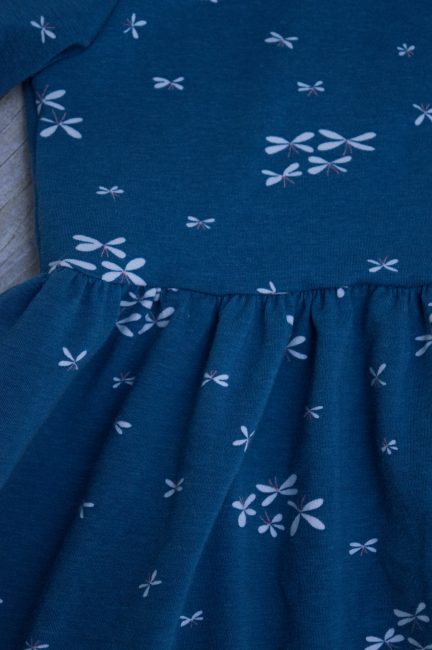
Grain of the Fabric
The direction of the warp and weft in woven fabric. Learn all about fabric directions and grains in our 3 Ways to Use Bias Tape tutorial.
Gusset
A gusset is a triangular or diamond-shaped piece of fabric inserted into a seam to add width or depth. It allows for ease of movement in garments, particularly underarms and crotches. Gussets also reinforce seams for added strength and durability. By using gussets, sewers can ensure that their finished products fit well, are comfortable, and allow flexibility. Understanding gussets is essential for achieving professional results in sewing projects, whether you're experienced or a beginner.
Hand
The feel and texture of a particular fabric. Check out our Knit Fabric 101 for a guide to different fabrics.
Hand wheel
Manually moves your needle up and down. See how to use the hand wheel in our Guide to Threading a Sewing Machine.
Hem
Hemming is a sewing technique that finishes fabric edges for a clean, polished look. It provides a finished appearance and prevents fraying. Different types of hems, like blind hems and rolled hems, offer unique looks. Hemming is an essential skill for seamstresses of all levels. The finished bottom edge of a garment. Learn how to sew a blind hem, how to hem a circle skirt, and how to sew hems with a sewing machine.
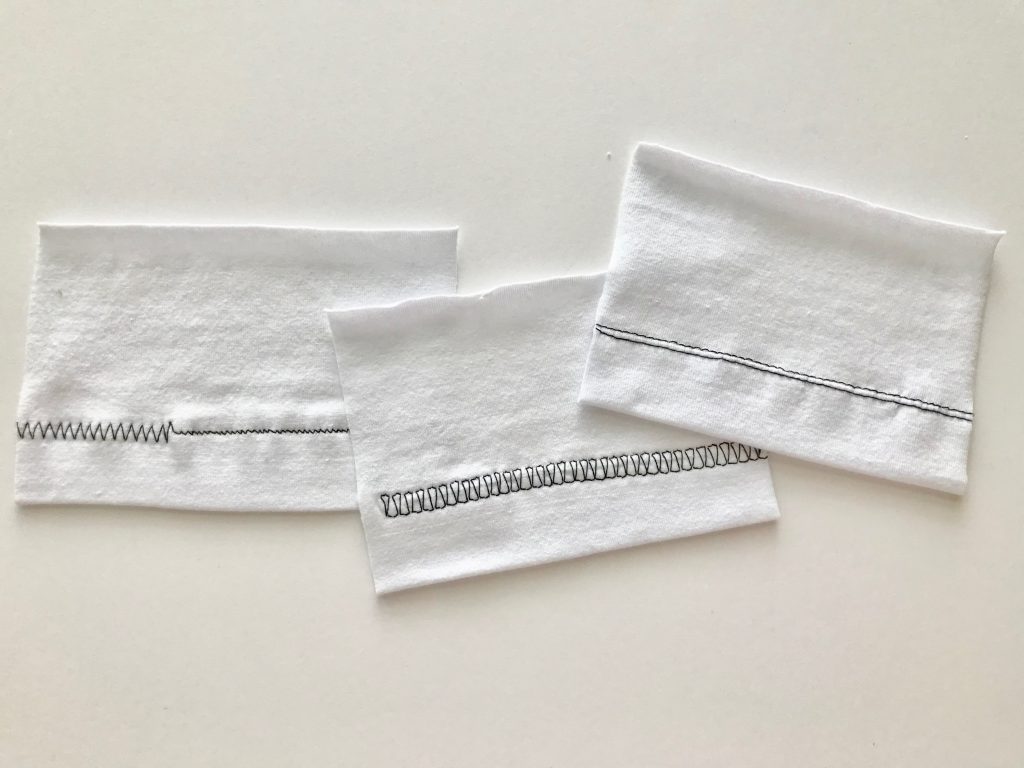
Interfacing
Interfacing is a crucial element in sewing that provides structure and support to garments. It is placed between fabric layers to reinforce areas or add body. Interfacing can be made from various materials, with different weights and thicknesses for desired effects. By adding interfacing to specific areas, sewers achieve a professional look. Properly using interfacing is essential for well-constructed garments, whether you're a beginner or experienced sewer.
Can be sewn or ironed on. Learn more in Sewing Interfacing 101.
Knit Fabric
Knit fabric is created by interlocking loops of yarn, giving it stretch and flexibility. It's ideal for garments like t-shirts, leggings, and sweaters that require ease of movement. Knit fabrics are comfortable, easy to work with, and come in various colors and patterns. Adding knit fabrics to your sewing projects can enhance comfort and style.
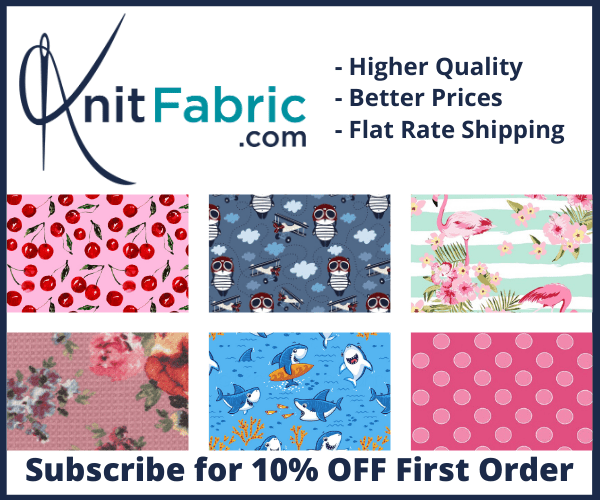
Lining
A layer of fabric underneath the main. We have a variety of Sewing Patterns that can be lined.
Muslin
A cheaper piece of fabric used to practice on for fitting purposes before sewing on the nicer fabric. Learn how to make a muslin as a practice run in the Button-Up Shirt Dress Tutorial.
Nap
When working with fabrics like velvet or corduroy, consider the fabric's nap - the direction of the fibers. Cut all pattern pieces in the same direction for consistent appearance and texture. The nap creates a smooth surface when brushed or rubbed in one direction. Cutting pattern pieces in different directions can lead to color and texture inconsistencies. Understanding and working with the fabric's nap is essential for professional sewing results.
Needle | How to Choose the Right Needle for Your Fabric?
When choosing the right needle for your fabric, consider the weight, type, and weave of the fabric. Generally, lightweight fabrics require smaller needles, while heavier fabrics need larger ones. Also, match the needle type to your project (e.g., ballpoint for knits) and adjust the needle size if necessary.
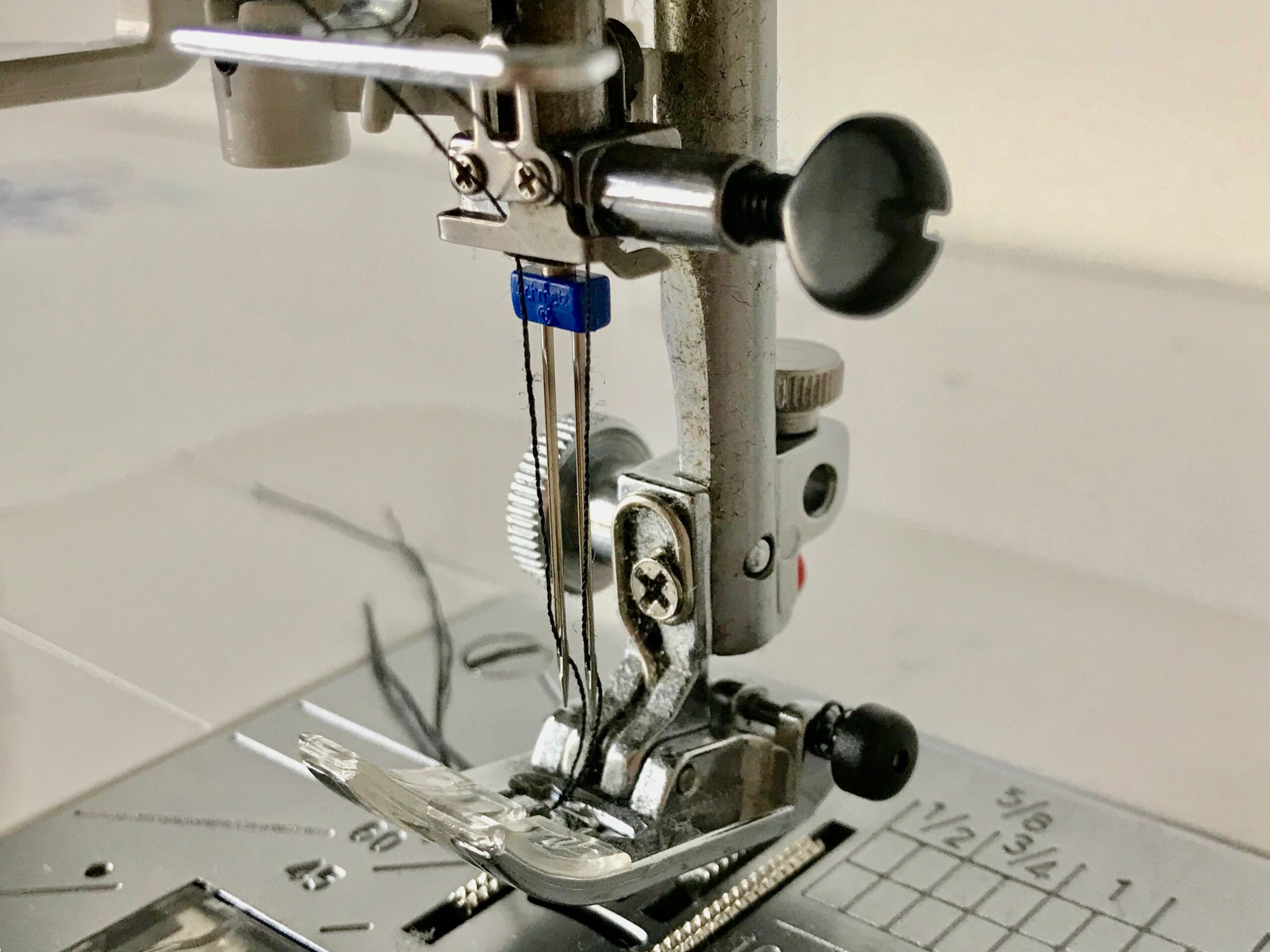
Needlework
Needlework is the art of decorative stitching and embroidery done by hand. It includes sewing, knitting, crocheting, and cross-stitching. With needlework, you can create intricate designs on fabric or other materials, like tapestries, lacework on clothing, or decorative stitches on quilts. It's a way to express creativity and create unique pieces.
Notch
A triangular shape on the pattern used to match pattern pieces together as you sew. Learn more about matching up pattern pieces HERE.
Notions
Notions, in sewing, are small tools and accessories used to create garments. They include buttons, zippers, hooks and eyes, snaps, ribbons, trims, and thread. Notions add functionality and decoration to finished pieces. They secure closures, add embellishments, and provide structural support. Sewers keep a collection of notions for their projects. From essentials to specialized items, notions bring creative visions to life in sewing.
Overlock
Overlock is a sewing technique used to finish fabric edges and prevent fraying. It involves using an overlock machine to trim the fabric and sew a seam along the edge, resulting in a neat and durable finish. Overlocking is commonly used in garment construction and for creating decorative edges on items like table linens or curtains. Mastering this technique can elevate your sewing projects to a professional level.
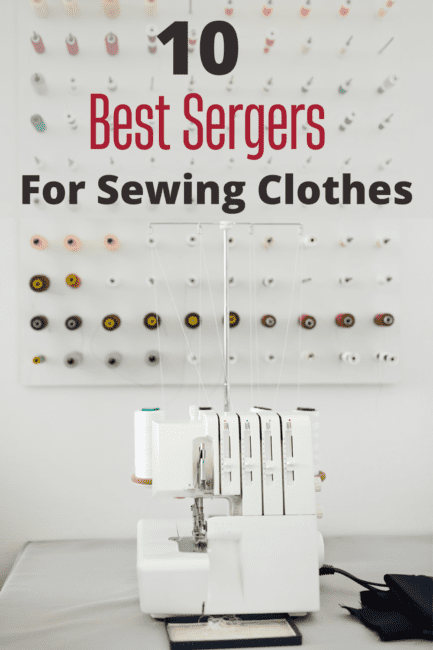
Patchwork
Patchwork is a popular sewing technique for creating unique designs. By combining small pieces of fabric, you can unleash your creativity and create quilts, blankets, and other textile projects. Cut fabric into different shapes and sizes, then stitch them together by hand or using a machine. Patchwork has a long history and is associated with traditional craftsmanship and folk art. Whether you're a seasoned quilter or a beginner, it's a versatile way to express your creativity through fabric.
Pattern
Sewing instructions and template pieces to create and finish a project. We have a great article on How to Use PDF Sewing Patterns.
Placket
An opening created for fitting a garment onto the body. Learn How to Sew a Placket.
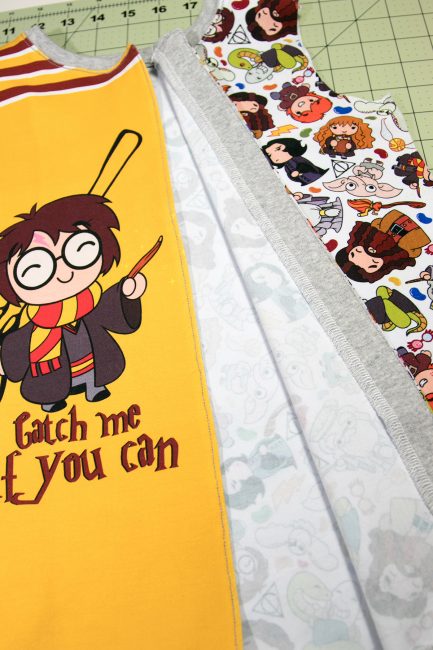
Pleat
Doubling a fabric onto itself to create a fold and then sewing together. Learn how to sew a box pleat or take a look at the DIY Pleated Skirt.
Presser foot
A piece of metal is located near the sewing machine needle that keeps your fabric in place while you sew. Learn more about using a presser foot in our How to Thread a Sewing Machine Guide.
Press
To iron your fabric. Pressing is an important part of sewing – take a look through our Pressing Aids Round-Up as well as our Guide to Pressing while Gathering Fabric.
Pre-wash
Washing your fabric upon receiving in like manner as you would wear the finished garment. Very important for colors that bleed a lot like red for example. Also aids in shrinking the fabric before you start/finish a project. For more information, take a look through our Guide on How to Prepare Fabric for Sewing.
Quilting
Quilting is a traditional sewing technique that transforms fabric into beautiful designs. It can be done by hand or with a sewing machine, allowing for endless creativity in pattern, color, and texture. The finished quilt can be used as a cozy blanket, wall hanging, or functional art. With its rich history and timeless appeal, quilting remains popular worldwide. Whether you're experienced or just starting out, this rewarding craft offers endless possibilities for creativity and expression.

Raw edge
Raw edge is an unfinished fabric edge, left exposed without additional finishing techniques. It's commonly used in sewing for a casual or rustic look, especially with lightweight fabrics. While raw edges may appear unfinished, they add a unique and edgy aesthetic. However, they can fray over time, so it's important to use appropriate stitching techniques or apply a seam finish to prevent unraveling. The raw edge technique allows for creative experimentation and adds texture to your projects.
Ruche
Ruche is a decorative sewing technique where fabric is gathered or pleated to create texture and visual interest. It adds dimension and detail to garments like sleeves, collars, or waistbands. Ruching can be done by hand or with a sewing machine using gathering stitches. It's versatile and adaptable to different styles and fabrics, offering endless creative possibilities in garment construction. Ruche adds elegance and sophistication to any sewing project.

Rotary Cutter
A circular blade is attached to a handle that glides and cuts across the fabric for a clean cut. Learn more about How to Use Rotary Cutters.
Spool
Spools are cylindrical objects used in sewing to hold thread or yarn. They come in different sizes and colors, allowing for easy organization and selection. Spools store and dispense thread, keeping it tangle-free and accessible for precise stitches. Whether you're a beginner or experienced, having a collection of spools is essential for sewing enthusiasts.
Seam
The line that holds two pieces of fabric together with thread. Take a look at our guide on 11 Ways to Finish a Seam.
Seam allowance
Seam allowance is the extra fabric added along pattern edges before sewing. It allows for adjustments and clean, finished edges. It varies based on the garment or project and is measured in inches or centimeters. Sewing with a proper seam allowance is crucial for well-constructed items and is a fundamental sewing skill.
Seam guide
A seam guide in sewing, either a physical attachment or markings on the machine, ensures accurate and consistent seam allowances. It provides a reference point for fabric, resulting in straight, even seams and precise sewing. Using a seam guide improves the quality and professional finish of sewing projects for beginners and experienced sewers alike.
Seam ripper
A sharp tool that cuts through stitches that need to be removed. Join us to learn How to Use a Seam Ripper.
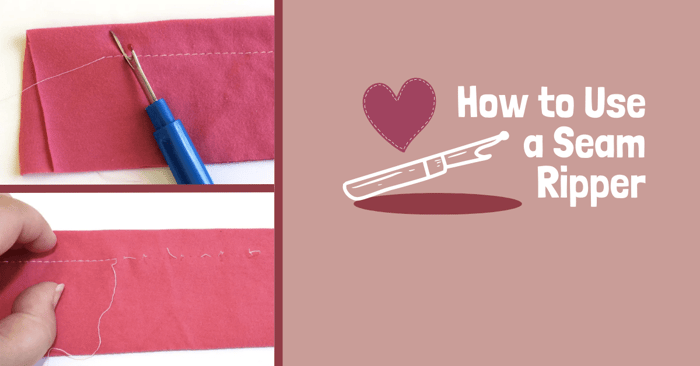
Self-healing mat
A cutting surface with measurements used for cutting that heals itself after use of a rotary cutter.
A self-healing mat is a must-have for sewing enthusiasts. It withstands wear and tear, making it essential for any sewing project. This innovative mat quickly recovers from cuts and punctures, leaving no visible marks or damage. It provides a smooth surface for precise measurements and accurate cutting. Whether you are a beginner or experienced, a self-healing mat enhances your sewing experience and helps you achieve professional results.
Selvedge
Selvedge, in sewing, refers to the self-finished edge of a fabric created during weaving. It is known for its tightly woven appearance and strength. Sewing enthusiasts use selvedge for decorative purposes or as a practical component in garment construction. By utilizing the selvedge edge, sewers can achieve clean and professional-looking finishes in their projects. Understanding selvedge is crucial for achieving high-quality results in sewing.
Serger
A serger, also known as an overlock machine, is used to create finished edges and seams on fabric. Unlike a regular sewing machine, a serger uses multiple threads to sew, trim, and finish the edge of the fabric in one step. This produces a neat and durable finish that prevents fraying. Sergers are essential for garment construction and other sewing projects where clean and sturdy seams are desired.
Shirring
Shirring is a sewing technique that adds texture and shape to garments. By stitching elastic thread onto fabric, you can create gathered rows for a unique and decorative effect. Use shirring to create stretchy waistbands, bodice details, or entire garments. This versatile technique adds visual interest and dimension, perfect for feminine and romantic designs. Whether you're experienced or a beginner, shirring is a fun sewing technique to explore in your next project. Check out our Guide to Shirring 101.

Staystitch
Staystitching is a sewing technique that stabilizes and prevents fabric distortion. It involves stitching along curved or bias-cut fabric edges before assembling a garment or project. This technique maintains fabric shape, prevents stretching, and is crucial when working with delicate or lightweight fabrics. Staystitching ensures precise and professional-looking results in your sewing projects.
Stitching Line
In sewing, the stitching line is where stitches join fabric pieces together. It determines the fit and appearance of a garment. Accurate marking and sewing along the line ensure proper alignment and a professional finish. Stitch length and type also affect seam strength and durability. Mastering the stitching line enables sewers to create precise, well-constructed projects.
Stitch Length
Stitch length is important in sewing as it determines the appearance and functionality of a garment. It is measured in millimeters or stitches per inch (SPI). A shorter stitch length creates a denser and more secure seam, suitable for delicate fabrics or areas that require extra strength. A longer stitch length works well for lightweight fabrics or decorative stitching. Adjusting the stitch length can greatly impact the quality and durability of your projects, so experimentation is key.
Straight stitch
The straight stitch is a fundamental sewing technique used to join fabric pieces in a straight line. It is versatile, easy to learn, and commonly used for garment construction, hemming, and topstitching. Its simplicity and clean finish make it an essential skill for sewers of all levels.

Thimble
Worn on the finger for sewing as a protective measure.
Thread
Fibers wound together to create a thin string.
Top stitch
Topstitching is a sewing technique that adds decorative stitching to the top layer of fabric. It reinforces seams and edges for durability and enhances the visual appeal of garments or projects. It can be done with a regular or specialized machine on hems, collars, cuffs, pockets, and other areas that need strength. Choose contrasting or matching thread for different effects. Topstitching gives a professional finish to sewing projects. Learn How to Topstitch Knits.
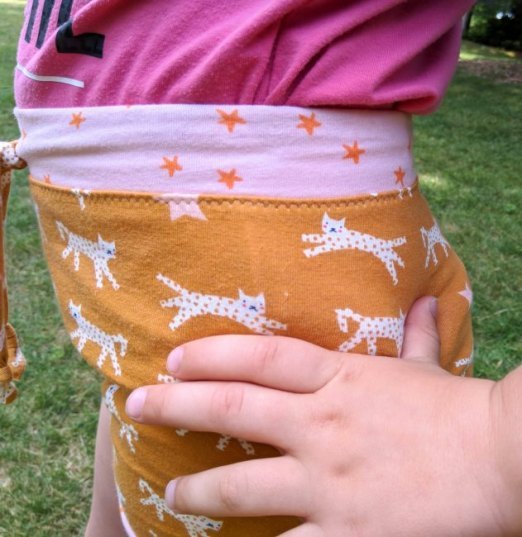
Turn
To leave a small opening after partially sewing an item enclosed to be turned right side out.
Walking foot
A walking foot is a sewing machine attachment that helps feed multiple layers of fabric evenly. It has top and bottom feed dogs that work with the machine's built-in feed dogs to ensure smooth movement of fabric layers. This prevents issues like shifting or puckering, especially with thick or slippery materials. Whether quilting, sewing leather, or needing precise stitching, a walking foot is an invaluable tool for professional-looking results.
Warp
In sewing, warp refers to the lengthwise threads of a fabric that provide stability and structure. They run parallel to the selvage edge and influence the fabric's drape and appearance. When cutting fabric, aligning pattern pieces with the warp ensures proper grainline alignment for optimal performance. Understanding warp is crucial for achieving professional results in garment construction and other sewing projects.
Weft
The crosswise thread in woven fabric.
WOF
Width of fabric.
Woven
A type of fabric that is made up of two sets of crisscross threads and only stretches across with the bias. Take a look at our Woven Fabric section at KnitFabric.om.
Wrong side
In sewing, the "wrong side" refers to the underside or back of a fabric. There is a right side and a wrong side when working with fabric. The right side is the visible finished side, while the wrong side is less visible and may have seams or markings. It's important to identify the wrong side when following patterns to ensure proper sewing and desired results.
Zigzag stitch
The zigzag stitch is a sewing technique that creates diagonal stitches in a back-and-forth pattern, resembling a zigzag. It reinforces seams, prevents fraying, and adds decoration to garments and fabric projects. This versatile stitch can be adjusted in width and length for different fabrics and purposes. Mastering the zigzag stitch will enhance your sewing projects and give them a professional finish.

Zipper foot
A zipper foot is a sewing machine attachment designed for sewing zippers onto fabric. It allows the needle to get close to the zipper teeth for accurate stitches. The foot has two sides for sewing on either side of the zipper. It's essential for achieving professional results in sewing projects involving zippers. Whether you're making garments, bags, or home decor items, using a zipper foot makes the process easier and more precise.
For more info, check out our Guide on How to Sew Zippers.
Yoke
In sewing, a yoke is a fabric piece that joins the front and back sections of a garment at the shoulders. It provides structure and support, ensuring proper fit and draping. Yokes can be found in blouses, shirts, dresses, and jackets, serving both decorative and functional purposes. They are crucial for creating well-fitting and stylish garments.
Thank you for joining us today to learn about different sewing terms and vocabulary. Now that you know all your sewing terms, be sure to get started with your sewing projects and come to join us in our Facebook Group.
